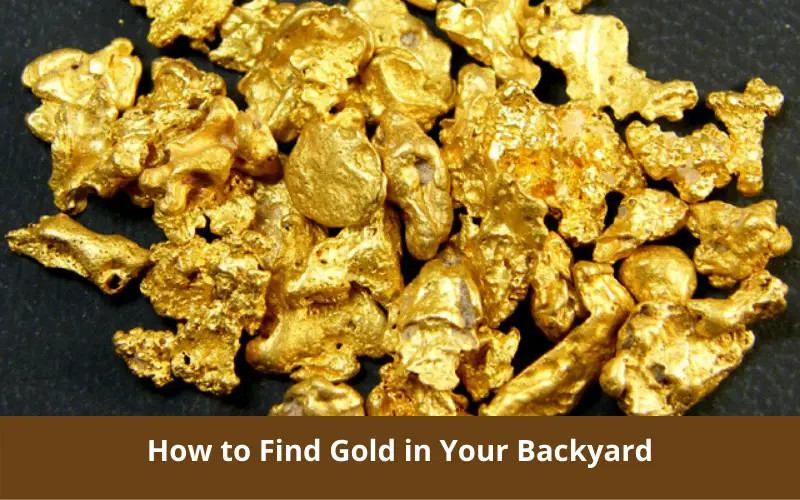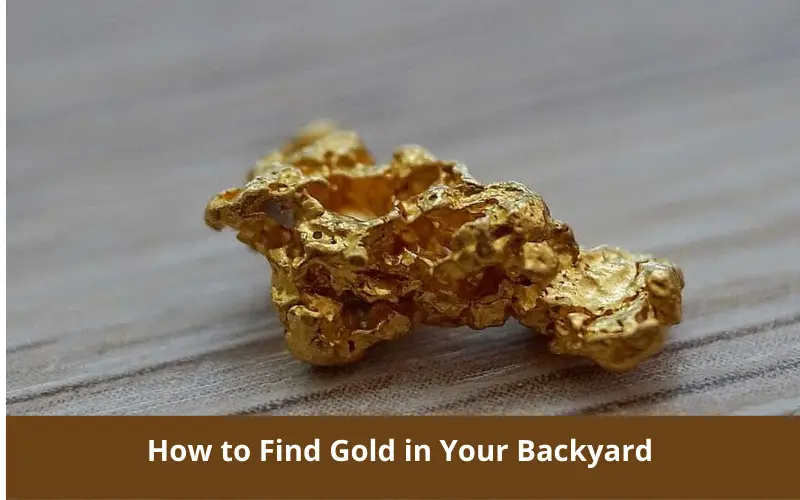Gold is rare and isn’t as abundant as other minerals. In other words, gold can be found anywhere but cannot be found everywhere.
After the California gold rush in 1848, some people have made it a mission to be part of the lucky ones who will eventually find gold.
While some aim to find in large areas and places suspected to have gold, others attempt to find gold in areas close to them, such as their backyards. But you might as well try, who knows, you might find even a speck underneath the soil.
Can Gold Be Found in Your Backyard?

Gold can be found in your backyard. If a river or a stream happens to flow through your backyard, then you are in luck because gold is likely to be found there. Gold is heavy and will reside at the bottom of rocks and soil.
If you live near mountains, areas of a previous gold rush, or areas close to the sea or a water body, you are liable to find gold.
You might find a speck that wouldn’t make you thousands or millions but will be the right size just for an ornament or jewelry.
Gold can be found in almost all the 50 States in the United States, as gold is usually mined there. However, they will be prominent in some areas and less in others.
Besides, it’s easier done in your backyard since it’s only a small area involved.
Recommended: How To Find Amethyst in Your Backyard.
How To Find Gold in Your Backyard
Finding gold requires some knowledge and possibly in-depth research on gold and possible locations where gold can be found. Also, don’t get your hopes up, be realistic about the whole thing. Don’t expect to be a millionaire overnight simply because you want to attempt to mine for gold, as you may only find small nuggets.
Knowing that gold is rare and that there is a probability of finding one in your backyard except for fear of failure or feel good even after attempting.
1. Tools you’ll need
- A metal detector
- A panning pan
- Water
- Water hose
- Shovels
- Canisters
- Claw tools
2. Physical Demand
Finding gold is physically challenging and exhausting. This process will require you to get your hands dirty, and your muscles stressed. It can also be mentally draining as it requires patience.
We suggest that you stay hydrated during the whole procedure and take a little time to rest in between; it helps. And if you lack the patience to sift through dirt for hours while crouched down, then you should reconsider your decision to mine.
3. Find A Spot to Dig On
You would want to start digging in areas with travels, sand, and rocks, as gold is likely to be found there. You can also find gold in locations close to a water body or even in a shallow river, stream, or lake. Mountainous areas should be considered.
When you have successfully selected an area suitable for digging, Mark the areas and start digging with your shovel.
During the digging process, you would want to use a claw told to remove obstructing rocks. Also, be cautious of your digging positions; you don’t want to have lower back pain.
After the digging is done, use a metal detector. A metal detector sends electromagnetic waves into the soil, and minerals—Gold— respond by also sending their electromagnetic waves.
A metal detector makes your work easier, and it is an excellent way to start. Be sure to mark the spot you have already dug; you do not want to give yourself extra work by sifting through places you have already dug.
Scoop up the dirt you have dug up and put them into your panning pan. Put the panning pan under running water (preferably tap water); you can use a hose if necessary.
For people mining in rivers and streams, tap water is not necessary to submerge the pan in water.
In panning, do not assume that a mining pan is the same as a kitchen pan. They are entirely different. A panning pan is wider than a kitchen pan, and it is shallow.
Shake the pan vigorously in a circular motion and then gently (still in a circular motion) under the running water. This will help to dissolve the dirt and wash them away.
Remove rocks so that you are left with sand and maybe gold that has sunk to the bottom of the pan. Panning for gold is physically demanding and may be required to be done for a long time.
If you come across any gold, wash it thoroughly and store it inside a canister, you don’t want your gold missing.
4. Watch Out for Fools Gold
Imagine the disappointment you would feel after finding a speck of gold, which was iron pyrite (fool’s gold). We will be explaining gold features to help you differentiate between fool’s gold and actual gold.
Recommended: How Do You Find Gemstones in Your Backyard
Features of Real Gold vs Fools Gold
1. Color
Fool’s gold is as vibrant as real gold, and it looks kind of brassy in color. In contrast, the real gold is shiny with a metallic yellow color.
Sometimes iron pyrite can look so similar to gold that it becomes hard to tell their colors apart. Luckily there is another way to identify fool’s gold.
2. Density
Iron pyrite is less dense than genuine gold. When there is a water movement, fool’s gold will move easily while real gold, heavier, will not move easily.
There are instances where people bite gold specks to determine whether it is real gold or the fake equivalent.
Iron pyrite is hard when bitten, while gold is soft when bitten, in order word gold is sectile. It’s the reason athletes at the Olympics bite on their gold medals.
3. Smell
Fool’s gold has a foul smell that resembles a rotten egg because it contains Sulphur. Real gold is odorless.
4. Texture
Its pyrite is brittle and will crumble easily. While real gold will flatten out when touched (using a hammer to test this out is helpful). Fools’ gold is crystalline and has sharp-edged, while real gold is smooth and has round.
5. The Scratch Tests
The scratch test can be used to tell the difference between gold and iron pyrite. For this test, you will need to get a piece of copper and scratch it against the said mineral.
If it leaves a mark, it is real gold. If it’s hard and doesn’t leave a mark, it is pyrite. You must be careful when carrying out this test as it can damage real gold.
There is another test to determine if what you found is gold or not. The magnifying test, the hallmark test, the float test, the skin test, the vinegar test, and the weight test. If you still aren’t sure, consult an expert. We have also included some helpful links.
Here is a video on how to tell the difference between gold and iron pyrite.
An article explaining the various test to determine if a substance is a gold.
What Happens If You Find Gold in Your Backyard?
Well, the finders’ keepers rule applies. Though we suggest, you check with the mineral rights of the area you reside in.
However, questions may arise on who might have buried the gold in your backyard and when it was buried. If you find a small nugget of gold, then you will be left alone.
But if you discover a large chunk of gold, investigations may be carried out to determine who owns the gold and how it should be shared.
Can You Legally Pan for Gold in Your Backyard?
Yes, you can legally pan for gold in your backyard. In some countries, recreational mining is restricted to shovel, a panning pan, and a metal detector. The use of other machineries such as dredges, or sluices is prohibited.
Is There Gold in The Ground Everywhere?
No. Gold is rare, and if it is found everywhere in the ground, it will be abundant and will be of low value. While gold can be found anywhere, it cannot be found everywhere.
Gold is usually mined in South Africa, the United States (Nevada, Alaska, Colorado), Russia, Canada, and Australia.
Conclusion
It is possible to find nuggets and specks of gold in your backyard, and while it can be physically demanding, it is an easy process if you know what you are doing.
When telling the difference between real gold and fool’s gold, it is advised that you carry out a few tests if you are not willing to see an expert.
Recreational mining is possible in your private property, and you may be able to keep any amount of gold you find (depending on your location.) We hope you are successful in your quest to find gold.
You May Also Like:
We trust this article helped you learn how to find gold in your backyard. You may also want to read our article on How To Find Amethyst in Your Backyard.
Thanks for taking the time to read our article, and we hope you find it helpful. Would you mind leaving a comment below if you have any suggestions?
Kindly reach out to people by sharing this post on social media.
If you liked this article, then please follow us on Facebook, Instagram, and Pinterest.

